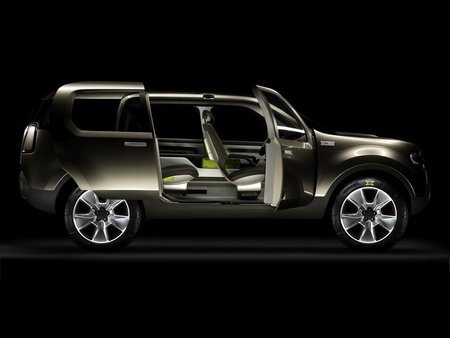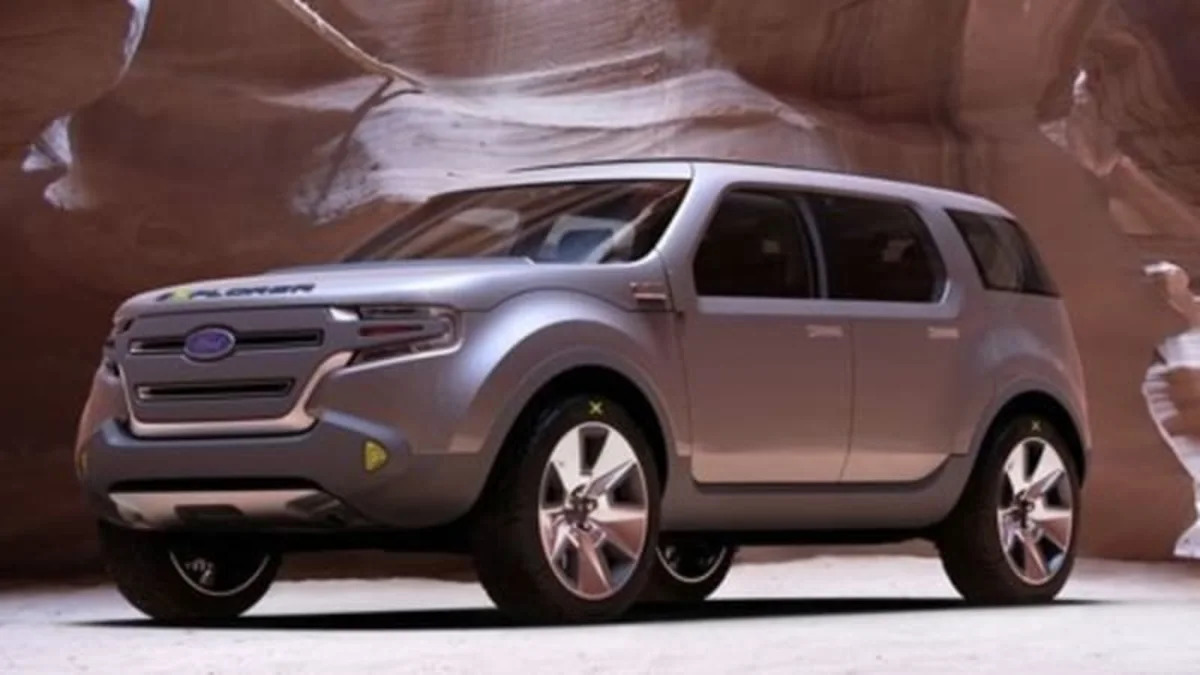click above for 50 high-res images of the Ford Explorer America Concept
For more than a decade the Ford Explorer was the top-selling SUV in the US with annual sales topping 400,000 units for many years. The best days of the body-on-frame SUV are clearly behind it, though, as the market has shifted toward crossovers like the smaller Escape and Honda CR-V, as well as larger vehicles like the Ford Edge. Ford has seen the light and the next generation Explorer is finally abandoning the traditional setup in favor of a new unit body design.
The new Explorer America concept that Ford is debuting at the 2008 Detroit Auto Show is the first public hint of where the Explorer is going in the coming years. When the Explorer is replaced around the end of this decade, the new model is expected to look much like this concept. The basic proportions and size are very close to the current Explorer, but the styling is a more modern look for this Ford stalwart. The combination of rising fuel costs and new fuel economy rules is pushing Ford to increase the efficiency of all their vehicles including the next generation Explorer.
[Source: Ford]
For more than a decade the Ford Explorer was the top-selling SUV in the US with annual sales topping 400,000 units for many years. The best days of the body-on-frame SUV are clearly behind it, though, as the market has shifted toward crossovers like the smaller Escape and Honda CR-V, as well as larger vehicles like the Ford Edge. Ford has seen the light and the next generation Explorer is finally abandoning the traditional setup in favor of a new unit body design.
The new Explorer America concept that Ford is debuting at the 2008 Detroit Auto Show is the first public hint of where the Explorer is going in the coming years. When the Explorer is replaced around the end of this decade, the new model is expected to look much like this concept. The basic proportions and size are very close to the current Explorer, but the styling is a more modern look for this Ford stalwart. The combination of rising fuel costs and new fuel economy rules is pushing Ford to increase the efficiency of all their vehicles including the next generation Explorer.
[Source: Ford]
With an emphasis on cost-effective ways of reducing fuel consumption, Ford is focusing on trimming vehicle weight as one means to that end. Ford's holistic approach to weight savings involves looking at all the systems in the vehicle. For example, the new SUV will drop the current engine lineup of the old 4.0L V6 and 4.6L V8 in favor of new EcoBoost gasoline turbocharged direct injection units (GTDI). The new lineup will consist of a 2.0L GTDI four cylinder with 275hp and 280lb-ft of torque and a 3.5L V6 with 340hp and 340lb-ft. In both cases the engines offer more power than the current units and fuel efficiency improvements of 30% and 20% respectively.
The V6 version of the new concept also weighs in at 150lbs less than the current V-8 model, which helps both the vehicle dynamics and overall fuel efficiency. What Ford is now calling the EcoBoost engines first appeared at last year's show in the Lincoln MKR concept as the TwinForce V6. That name has been retired in order to put the emphasis on the fuel efficiency-boosting potential of the technology. More gains come courtesy of the smoother body which, combined with reductions in parasitic losses from systems like the electric power assist, gives a five percent mileage boost.

On this concept, Ford is also trying out some interior packaging innovations as well. The first and second row seats are mounted on arms cantilevered from a rail mounted on the side of the center tunnel. With no seat mounting mechanism attached to the floor, a switch allows the second row seats to motor forward and stack beneath the front seats, providing easy access to the back row.
The sliding door on the passenger side and absent B-pillar are probably concept-only features that will never get to production. The integrated, matte finished three bar grille does look like an sensible evolution of the corporate face for a new decade. The concept has a bit of a chopped look to the roof profile giving a more aggressive look to the whole vehicle. Now that the Explorer will have a unibody layout with a lower floor, such a roof profile is certainly feasible without sacrificing interior volume.
Overall, the concept is an attractive update of a traditional shape with a lot of neat features and a fantastic new drivetrain. The base four-cylinder EcoBoost engine provides an additional 75hp and 25lb-ft of torque (with a much fatter, flatter torque curve to boot) with a 5mpg improvement over the current truck's base engine. The sooner Ford puts the old Explorer out to pasture the better. The new Explorer should turn up before the end of the decade. It better get here before there's no one left who wants to buy one.
PRESS RELEASE:
FORD TO REVEAL NEW FUEL-SAVING CONCEPT IN DETROIT
The Ford Explorer America concept showcases a new kind of utility for the vehicle customers have known and loved for years: even better fuel efficiency.
"Customers are smart. They value vehicles – the more efficient, the better," said Jim Farley, Ford group vice president of Marketing and Communications. "Ford gets it.
"Innovative technologies can transform people's favorite vehicles. Look at SYNC, the Ford system that connects people and their favorite portable devices, including media players and Bluetooth-enabled mobile phones, while in their vehicles."
Technologies and engineering innovations help Explorer America concept deliver an approximately 20 to 30 percent fuel-economy improvement, depending on engine selection, while providing room for six and their gear as well as moderate towing and off-roading capabilities.
This smarter utility concept simplifies Ford Motor Company's systems approach for delivering sustainable vehicles, specifically demonstrating:
- A powertrain lineup that includes a 4-cylinder 2-liter engine with EcoBoost technology delivering 275 hp and 280 lb.-ft. of torque or, as a premium engine, a 3.5-liter V-6 delivering about 340 hp. Depending on engine selection, fuel-efficiency will improve by 20 to 30 percent versus today's V-6 Explorer
- Migration from current body-on-frame to unibody construction, reducing weight and delivering superior driving dynamics
- A fuel-efficient 6-speed transmission with auto shift control, allowing the driver to select and hold a lower gear with just the turn of a dial when conditions warrant it
- A weight reduction of 150 pounds for the V-6 version thanks to its downsized – yet superior performing – engine, as well as more lightweight materials, suspension and chassis components
- Fuel-saving electric power assisted steering (EPAS) and other engine actions that deliver a fuel savings benefit of about 5 percent. Between 80 to 90 percent of Ford, Lincoln and Mercury vehicles will have EPAS by 2012
In addition to its fuel-efficient powertrain and technologies, the Explorer America concept addresses how the SUV market has changed in the past 15 years.
In the 1990s, customers were drawn by SUVs aligned with people's adventurous, more rugged lifestyles. Today's consumers are more discerning, demanding products that are capable and flexible – but more intelligently executed.
The Explorer America concept looks the part, too, with a modern, muscular design language that belies its ability to harness today's active lifestyles. Its integrated three-bar grille, defined power dome hood, wrap-around rear glass panel window and sliding rear door give the appearance that this concept is ready for modern Lewis-and-Clark types to explore, from their own neighborhoods to the trail head.
Inside, intelligent features abound, including: single-touch stackable, sliding seats that allow for convenient access to the second row; a work table with seats deploy from the tailgate; and a three-dimensional compass and navigation unit with a topographical map built right into the instrument panel.


Sign in to post
Please sign in to leave a comment.
Continue